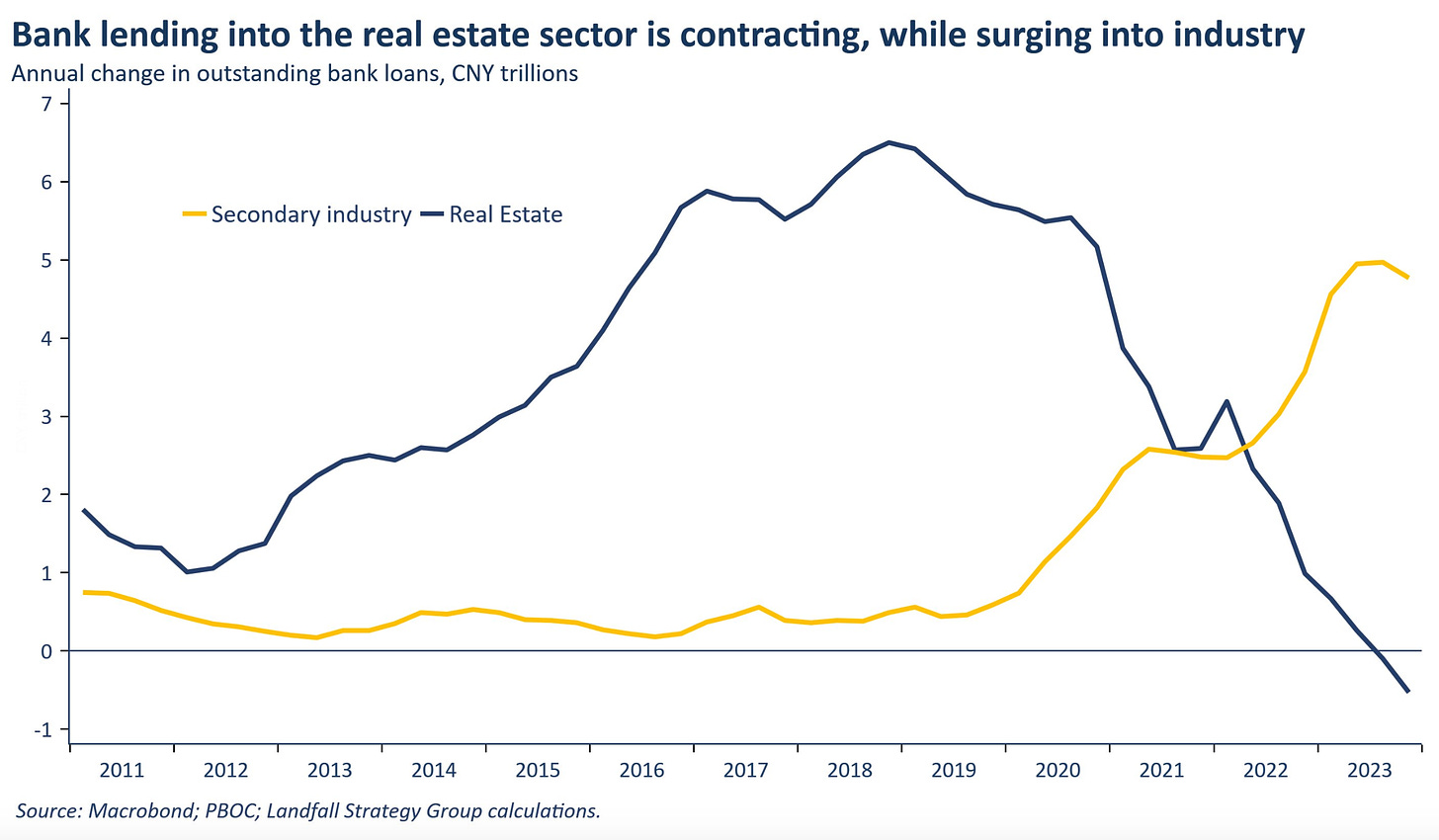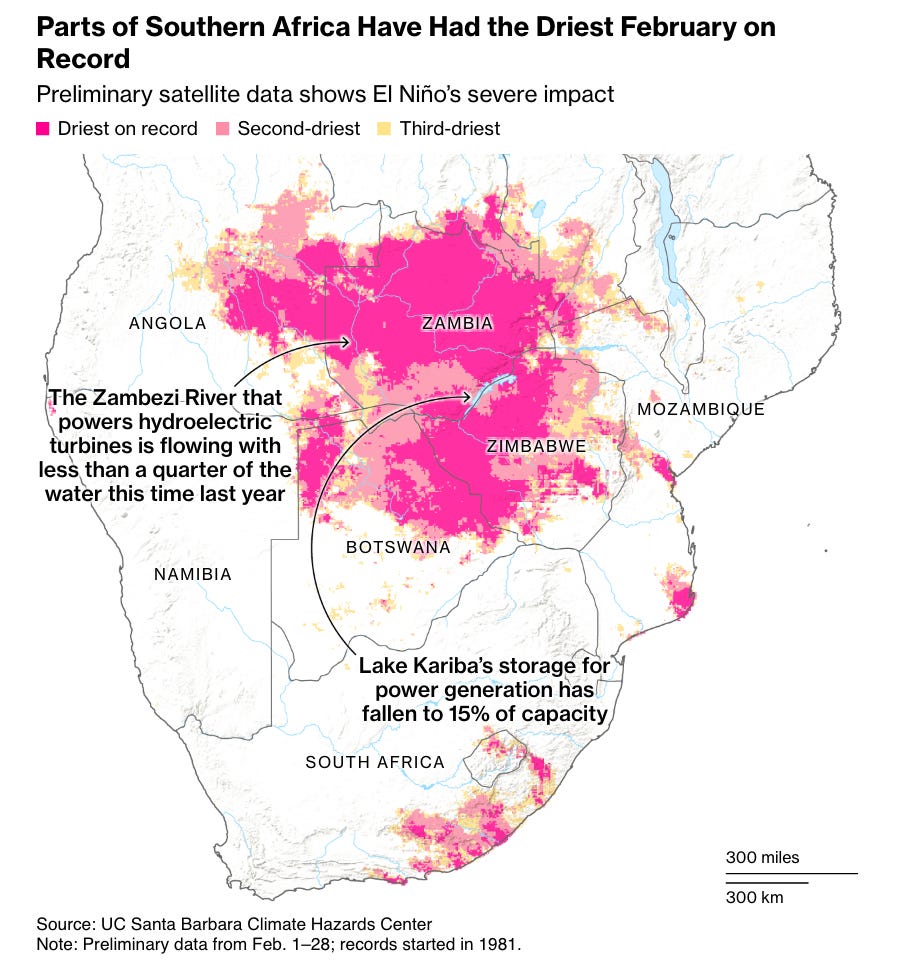China's investment shifts gear, Sudan's refugee crisis spills over, southern African drought & America's history crisis
Great images, links & reading from Chartbook Newsletter by Adam Tooze
Leiko Ikemura, Ocean III (Between Horizons), 2000/01, Hilti Art Foundation
Thank you for reading Chartbook newsletter.
China’s economy shifts gear
What keeps this project going are volutnary subscriptions from readers like you. To join the supporters club, please click here and pick a subscription option.
Sudan’s refugee crisis is spilling over to Egypt
… the intense fighting (in Sudan), the breakdown of the health care system, and a looming famine have already compelled more than 7 million people to seek refuge in safer locations within and outside of Sudan’s borders. As of the end of January, around 450,000 Sudanese refugees had fled to neighboring Egypt since the outbreak of war. Although they are safe, they face dire economic conditions, shortages in aid funding from international organizations, and a lack of opportunities to earn a living and settle in Cairo. With little prospect of returning home soon, the growing Sudanese refugee population, largely ignored by the international community, is stuck in limbo. Before the war, Khartoum was a host city for refugees fleeing neighboring countries, including the war in Ethiopia’s Tigray region and military conscription in Eritrea. Now, even ordinary civilians are at great risk in the capital and nearby cities such as Omdurman. As the crisis worsens, the aid available for Sudanese refugees remains deeply inadequate. On Feb. 7, the United Nations appealed for $4.1 billion to provide urgent assistance to civilians affected by the conflict, including those who have fled. Amid soaring inflation in Egypt, many new arrivals from Sudan have struggled to find affordable housing and are living in overcrowded apartments. Egypt’s existing Sudanese community, which had grown to an estimated 4 million before the war, helps to provide support for the newcomers, but is increasingly overwhelmed.
… and the EU is willingn to pay to keep it there.
The EU is readying a €7.4bn aid package for Egypt aimed at shoring up its economy, amid fears that the conflicts in Gaza and Sudan risk exacerbating financial troubles in the north African nation and raising immigration pressure on Europe. European Commission president Ursula von der Leyen will travel to Cairo on Sunday with the Greek, Italian and Belgian prime ministers to finalise and announce the agreement. …. It follows other agreements with Tunisia and Mauritania that pledged money and other incentives in return for better policing of the countries’ borders, despite concerns from politicians and NGOs over human rights and the effectiveness of such arrangements. The deal concludes months of negotiations that accelerated in the wake of the October 7 attack on Israel by Hamas militants and the subsequent war, amid fears of potential refugee movements from Gaza. But Egyptian authorities have kept their border to the enclave sealed and repeatedly rejected the idea of Israel attempting to displace large numbers of Gaza’s 2.3mn inhabitants to the Sinai peninsula. The agreement includes support for Egypt’s energy sector and assistance to deal with the rising number of Sudanese refugees in the country. It also pledges help to fortify Egypt’s border with Libya, from where people are crossing the Mediterranean en route to Europe, according to several EU officials briefed on the matter. The planned package includes €7.4bn in grants and loans through to the end of 2027. Some €1bn in emergency financial assistance could be paid immediately. Another €4bn in macro-financial assistance, tied to reforms under an expanded IMF programme under discussion, would need to be approved by EU member states. …. An official involved in the preparations said the agreement was “substantial but strategically important”, adding: “We’re worried about two borders — the Sudan-Egypt border, … and the Egypt-Libya border….” … According to the UN’s refugee agency UNHCR, Egypt hosts about 480,000 registered refugees and asylum seekers, most of whom fled the civil war in Sudan that broke out in April 2023. A second EU official briefed on the discussion said the deal was likely to repackage some existing EU support programmes for Egypt, which has long been an important partner for the bloc. … Egypt has a patchy human rights record, and the government of President Abdel Fattah al-Sisi, who took power in a 2013 military coup, has repressed dissent. Last year, 26,500 Egyptians applied for asylum in the EU, up from 15,400 in 2022, according to the EU Asylum Agency. The European Commission and other politicians have defended the agreements as a viable tool to manage immigration, given an increase in arrivals to the bloc. “We can talk about the human rights situation in Egypt as much as you want,” Greek migrant minister Kairidis said. “But I also have this real situation.”
Source: FT
Japan’s EV laggards band together
For subscribers only
Southern African drought
A swathe of southern Africa about the size of France suffered the driest February in decades, killing crops and precipitating a power shortage that threatens to hit copper mines in a key producing region. Last month, large parts of Zambia, Botswana and Zimbabwe had the least rainfall — or close to it — since records began in 1981, early data from the University of California Santa Barbara’s Climate Hazards Center show….
The dry spell, blamed on the El Niño weather phenomenon, is the latest indicator of how severely Africa is being impacted by extreme weather events that scientists say are becoming increasingly frequent and severe because of climate change — even though it produces far less global-warming gases than developed regions. Zambian President Hakainde Hichilema last week declared the drought a national disaster — an estimated 45% of planted areas have been destroyed just as the staple corn crop should be maturing. In Zimbabwe, some farmers have given up trying to grow and harvest their crops, allowing cattle to graze on what’s left. Water flows in the Zambezi River, which powers turbines that both nations rely on for electricity, are less than a quarter of what they were a year ago. ….The cost of corn in Zambia surged an average 76% in February from a year ago. In neighboring Zimbabwe, US dollar prices for the cereal have shown a similar increase since December alone, according to the Famine Early Warning Systems Network. In some areas, prices doubled within three months. Zimbabwe’s government has warned that the 2024 harvest may be half of last year’s. … The World Food Programme anticipates that about a quarter of the rural population will run short of grain in the first quarter. …. Large parts of Botswana have also been scorched by El Niño, with the Botswana Meteorological Services noting that the vast majority of the country was receiving significantly less rain than normal. Farmers who receive government support planted less than half the area in the current season than they did in the previous one. In Namibia, water levels in dams are already at dangerously low levels. The main reservoir supplying the capital, Windhoek, is only 11% full and dropping .. Zambia relies on hydropower for about 85% of its electricity generation and water levels at Kariba, the world’s biggest man-made freshwater lake which is fed by the Zambezi, have plunged to 15% of storage capacity — meaning power will have to be rationed. Zimbabwe has already increased the severity of it’s rolling blackouts. … Zambia's state power utility will on March 11 start rolling blackouts lasting eight hours daily. It plans to ask mines in Africa's second-biggest copper producer after the Democratic Republic of Congo to cut their power use by as much as 25%. … The International Monetary Fund warned the drought may also increase financing needs for Zambia, which has been grappling with a convoluted debt-restructuring process for more than three years. El Niño is mainly a seasonal phenomenon that makes extreme weather and climate events more likely, according to the World Meteorological Organization. The current event is one of the five strongest ever recorded …
Source: Bloomberg
Leiko Ikemura, Haruko I, 2017, private collection, courtesy of Jim Murren, Chairman of MGM Resorts
The crisis of academic history in the USA is a crisis also for the national security state
History is in an unprecedented crisis. Battered by budget cuts and a refusal to replace retiring historians, university history departments in the USA are now rapidly shrinking; a 2022 study of Midwestern history departments found that the number of permanent departmental faculty had declined by nearly a third since 2010. That decline continues to accelerate as university hiring of historians remains stuck at levels well below what is necessary to replace retirements. As a consequence, trained historians struggle to find jobs in the field: The rate at which people with history PhDs find tenure-track employment within four years of graduation has declined dramatically, from 54 percent for the 2013 PhD cohort to just 27 percent for the 2017 cohort. In 2022, only a miserable 10 percent of the 2019 and 2020 cohorts were employed as full-time faculty members. Departments have responded with drastic cuts to the number of historians they train; since 2010, the number of PhDs earned in history—which had tracked with jobs in the field since the 1970s—has dropped by 31.9 percent. … This policy-created collapse of the history discipline has direct impacts on national security. The Department of Defense is one of the largest employers of academic historians in the United States, in positions ranging from office training as part of the service academies or Professional Military Education to unit-level command historians responsible for chronicling and analyzing the operations of their units and fielding requests for historical data. Department of Defense historians also curate the histories of entire branches and engage in publishing in support of the military’s mission (as with the Army University press). Wayne Lee, vice president of the Society for Military History, estimates that the Department of Defense employs roughly 300 historians with PhDs at any given time. The Department of State does much the same with its Office of the Historian and broad reliance on historical expertise as a form of knowledge about other countries.
Bret Devereaux, in Foreign Policy
German public transport faces a demographic shock
For subscribers only
Long COVID Part 2 on Ones and Tooze
How economically disruptive is COVID-19 today as an acute illness?
Which pharmaceutical companies have most benefited from COVID-19 treatments?
And have people measurably changed their behavior when it comes to using sick days?
Those are a few of the questions that came up in my conversation with Cameron Abadi on our FP podcast Ones and Tooze. You can listen and read more here.
Approval ratings of democratic politicians
For subscribers only
Leiko Ikemura, Girl in Blue, 2022
If you have got this far, you know you want to click








